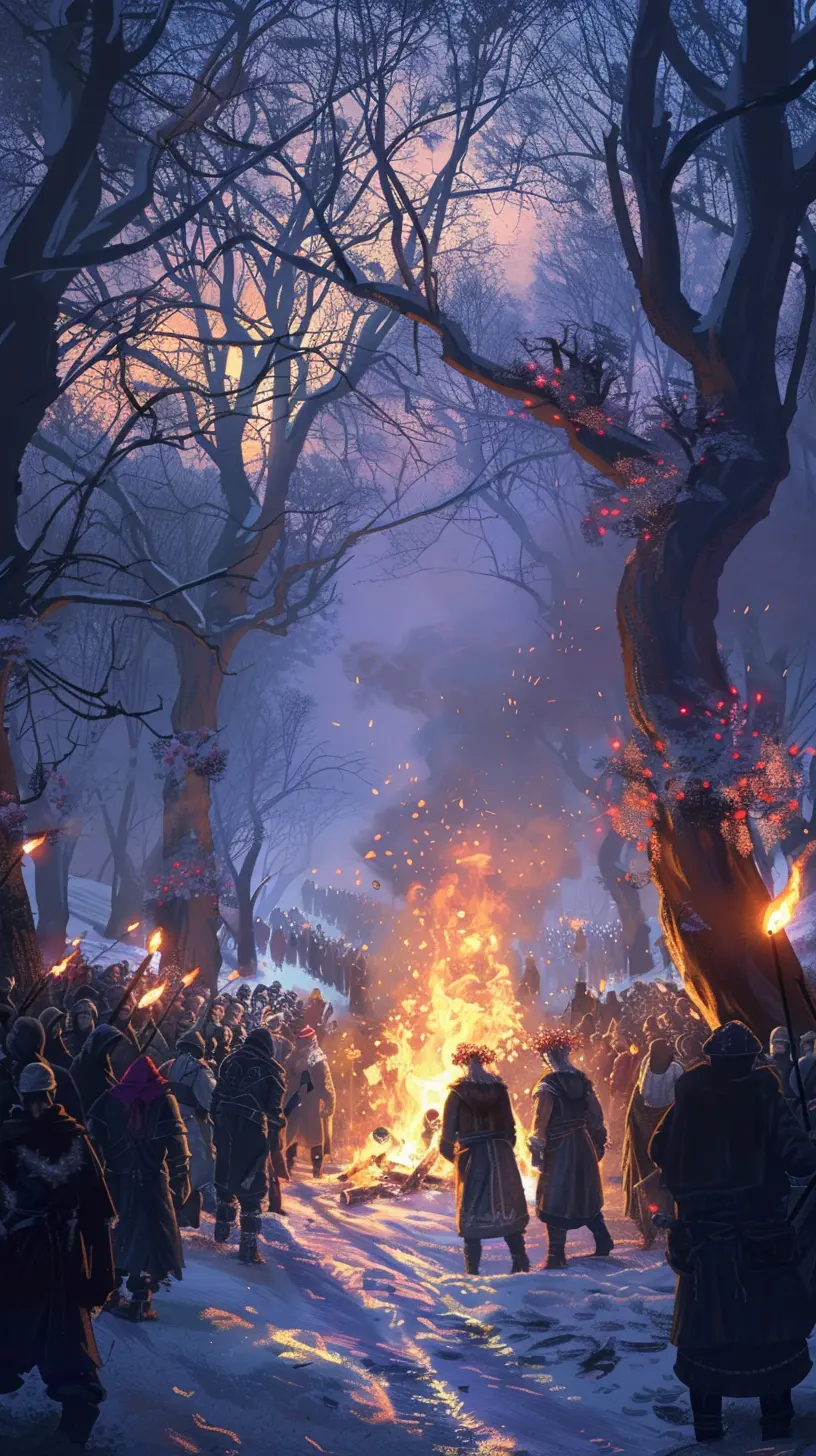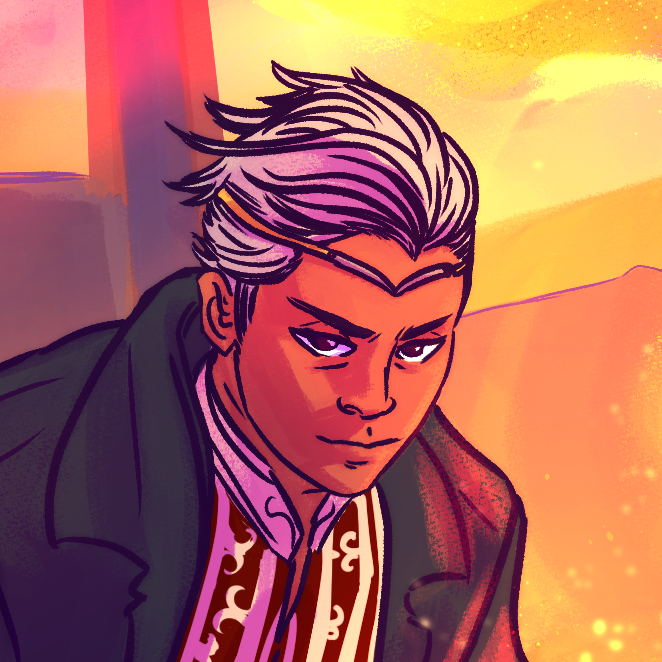Yearsend Wreath
For old times past...The Yearsend wreath is a hand-wrought wreath of branches, leaves, and dried flowers worn on the head as a crown-like adornment. It is an ephemeral thing in tradition, crafted in the last days of the current year and ceremonially cast into a bonfire to celebrate the dawn of the new year.
Though today many cultures have adopted Yearsend wreathes into their annual tradition in many different forms, the original wreathes were born in central Valathe in antiquity, and are generally attributed to the region that is now the Vostene Republic and its surrounds.
Magical variants of yearsend wreaths, including some that renew themselves each year akin to a phoenix reborn in fire, are available as rare and incredibly precious magical items. The most famous of these are the four seasonal crowns: Spring's Bloom, Summer's Light, Autumn's Bounty, and Winter's Kiss.
These wreaths appear semi-randomly across Valathe in each of their titular seasons, always in the hands of someone who has participated in a previous Yearsend celebration.
It is said that these four wreaths belong to four fey lords or ladies, and are given out to mortals that attract their favour over the year as the seasons pass.
Weaving a Yearsend Wreath
I heard Innesfen considers rowan unlucky if you use it in a yearsend wreath. Weird! Our way is better: rowan means you're going to have a blessed year.Constructing the wreath itself is a relatively simple task, at base. The celebrants must venture into the forests nearby and find branches with some flexibility to them, which can sometimes be challenging in the depths of winter when all is frozen. If nothing with enough flexibility is available, then there are a number of techniques to bend wood - steaming it or soaking it are the two most common. When enough of these have been gathered, the weaving can begin.
It always begins by creating a circle, usually by wrapping a gathered branch or vine around the celebrant's head and making a knot at its ends by weaving it through itself. From that circle, more branches can be woven in, always entwined around the existing loop to ensure it remains one singular wreath. When a solid base wreath has been formed, the celebrant can begin adding leaves, flowers, and other gathered goods into the wreath.
Berries are a frequent addition as well, serving as a nice pop of colour, but only those that bloom in winter. Flowers are often dried earlier in the year specifically to be saved for yearsend wreaths, and families often keep entire books of dried flowers to select the ones they would like to add in.
The actual flowers, berries, grasses, branches, and the like used differ greatly depending on what area of the continent the tradition is being undertaken in, as it heavily relies on local flora, but some things are universal - like snowdrops, violets, hellebore, and ever-lucky heathers.
Welcoming the Year
Let flame take the old, and bring ash anew!
The pyres that the wreaths burn on are known as the dawnfires in Yearsend tradition, and are constructed from loose wood fallen through winter or leftover firewood in each town. Wood that has been carved or shaped by mortal hands is deliberately excluded from these pyres - they must be created by nature's gifts alone. They are lit, too, without magic.
There are a number of techniques and traditions around lighting the fire, such as one town's intriguing tradition of using shaped glasses to light the fire with sunlight alone, but the most common method is to throw a lit torch into the bonfire while singing songs of celebration and welcome.
The wreaths are usually cast into flame as part of a procession, with each celebrant cheering joyfully as they bid farewell to their craft and greet the new year as it arrives. Some traditions involve specific songs or chants, and some communities add religious aspects into the ceremony by invoking prayers as the wreaths burn. This is, naturally, controversial.
History
And they'll take advantage of your kindness yet...When they first appear in historybooks, yearsend wreaths seem to dawn in multiple cultures across Valathe at the same time, with the Vostene Republic claiming its dubious title as the original location for their rise only because historical record there is dated earlier. This would usually denote that the wreaths were popularised by a leader in those times by intent, or that there was some other concerted effort resulting in their sudden prominence in Valathean culture.
The actual cause of their mass appearance, as determined by scholars over the past century, was another aspect of the wreaths. Long-forgotten by mortals, yearsend wreaths have always held another meaning to the fey. As fey are creatures of the woods and often feared by mortals, the donning of a yearsend wreath was once considered somewhat of an olive branch from mortals to fey.
Anyone crafting one would meet no harm when finding branches and leaves for their wreaths, so long as they did not seek to seriously damage the forests. Anyone wearing one would meet no harm from the fey, so long as it was not worn for too long, as to don it for overly long would be considered taking advantage of fey hospitality.
In turn for the fey's hospitality, mortals turned a blind eye to fey taking part in their celebrations, or actively welcomed them in. They would leave food and treats in obscure places for the fey to dine on, and lay out decorations for them to wear.
Lingering Impact
History fades, but its stain remains with us... hidden in the ashes, year after year.While the faerie history of the wreaths has been unfortunately lost, the traditions have remained. Yearsend celebrations are known to be accepting of any and all, no matter their face or manner, and it is quite common for Yearsend tradition to include masks or other mysterious guises for celebrants.
This way, the fey are still welcomed in - and doubtless they laugh at the mortals not realising what pact they have become part of!
Though treats are not deliberately left out these days, they have instead become part of the celebration's decorations, and the fey must thusly consider the offer extended. If you have ever had your Yearsend treats vanish - you can now assume who was behind it!
Yearsend wreaths have only become more important since their initial creation. The bonfires have gotten larger, the celebrations more ostentatious, and the wreaths themselves have gone through many a change. Yet the bones of the tradition remain the same, no matter what: at the end of the year, townsfolk craft wreaths from what they can and celebrate the new year's arrival. And that is what is most important, is it not?
Year after year, winter after winter, people of all kinds gather and spend time with one another.
I wrote a wish in my wreath once. My wife, she'd been struggling... we wanted a child, but never were are attempts successful. The weight of it was far heavier on her... I do not know who granted our wish, but she fell pregnant two weeks later. My son greets the new year with us, this time.
Alternative Wreaths
As the tradition of yearsend wreaths spreads, it has reached areas that find its requirements of vegetation and flame to be challenging. Communities that live in the depths of the Underdark have little vegetation available to burn aside from that which is deliberately cultivated, and flame may be challenging to ventilate. Likewise, high-altitude communities exist largely above the tree line and contend with large amounts of snow and ice that can make fetching plantlife a serious challenge. Fire is easier, as they typically have solutions for cooking fires, at least. Underwater communities find it easy to gather items for the wreath, with seaweed being plentiful, but naturally run into issues with burning the wreath once the new year arrives. In place of the ability to follow the basic steps, celebrants in plantless areas craft wreaths from whatever they know they may be able to destroy. Underdark celebrants thread fungi and cave mosses onto thin rings of glass, and shatter them into pits of acid when the year arrives. High-altitude celebrants adopt wreaths of snow and ice, and watch them melt in the new year's sun. Underwater communities release their wreaths into rip tides and areas of high currents so that the wreaths will be shredded by the water and taken far away. The tradition ever lives on.Even at war, we honour the tradition. There's always a ceasefire sometime in those days. Time enough to make them, and then as the new year starts, time enough to set a fire. It's harder on the battlefield. Can't let the enemy see your fire unless it's on the front lines, and that's risky. But we manage, every year. And we'll keep managing. We're not fighting demons.
















Happy New Year everybody! May 2025 be kind to us all <3